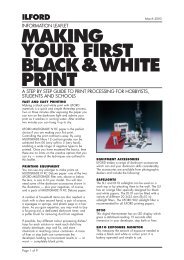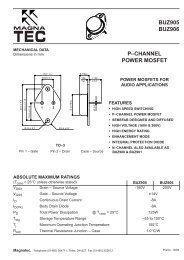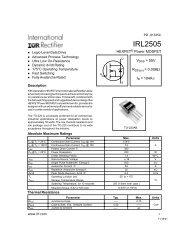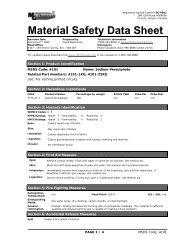SWITCHMODE⢠Power Supply Reference Manual
SWITCHMODE⢠Power Supply Reference Manual
SWITCHMODE⢠Power Supply Reference Manual
Create successful ePaper yourself
Turn your PDF publications into a flip-book with our unique Google optimized e-Paper software.
SMPSRMLosses and Stresses in Switching<strong>Power</strong> SuppliesMuch of the designer’s time during a switching powersupply design is spent in identifying and minimizing thelosses within the supply. Most of the losses occur in thepower components within the switching power supply.Some of these losses can also present stresses to thepower semiconductors which may affect the long termreliability of the power supply, so knowing where theyarise and how to control them is important.Whenever there is a simultaneous voltage drop acrossa component with a current flowing through, there is aloss. Some of these losses are controllable by modifyingthe circuitry, and some are controlled by simply selectinga different part. Identifying the major sources for loss canbe as easy as placing a finger on each of the componentsin search of heat, or measuring the currents and voltagesassociated with each power component using anoscilloscope, AC current probe and voltage probe.Semiconductor losses fall into two categories:conduction losses and switching losses. The conductionloss is the product of the terminal voltage and currentduring the power device’s on period. Examples ofconduction losses are the saturation voltage of a bipolarpower transistor and the “on” loss of a power MOSFETshown in Figure 23 and Figure 24 respectively.COLLECTOR-TO-EMITTER(VOLTS)RISETIMEDYNAMICSATURATIONSATURATIONVOLTAGEV PEAKSTORAGETIMEFALLTIMEDRAIN-TO-SOURCE VOLTAGE(VOLTS)RISETIMEON VOLTAGEV PEAKFALLTIMECOLLECTOR CURRENT(AMPS)PINCHING OFF INDUCTIVECHARACTERISTICS OF THETRANSFORMERTURN-ONCURRENTCLEARINGRECTIFIERSSATURATIONCURRENTTURN-OFFCURRENTI PEAKCURRENTTAILDRAIN CURRENT(AMPS)TURN-ONCURRENTCLEARINGRECTIFIERSPINCHING OFF INDUCTIVECHARACTERISTICS OF THETRANSFORMERON CURRENTI PEAKTURN-OFFCURRENTINSTANTANEOUS ENERGYLOSS (JOULES)TURN-ONLOSSSECONDBREAKDOWNPERIODSATURATIONLOSSTURN-OFF LOSSSWITCHING LOSSCURRENTCROWDINGPERIODINSTANTANEOUS ENERGYLOSS (JOULES)TURN-ONLOSSON LOSSTURN-OFF LOSSSWITCHING LOSSFigure 23. Stresses and Losseswithin a Bipolar <strong>Power</strong> TransistorFigure 24. Stresses and Losseswithin a <strong>Power</strong> MOSFEThttp://onsemi.com24













